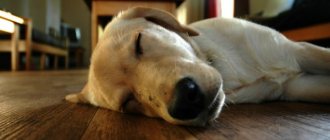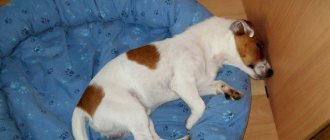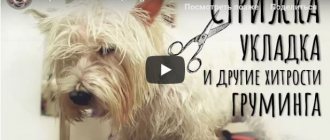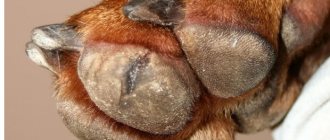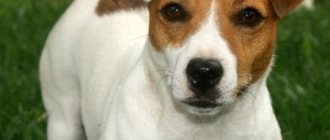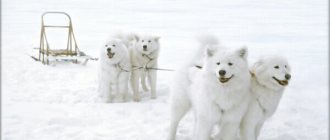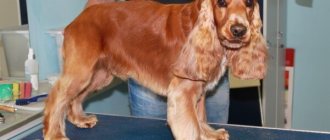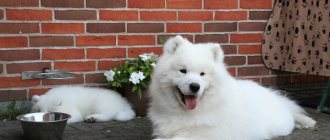Samoyed huskies are one of the most ancient dog breeds on Earth. They have a charming appearance, a wonderful flexible character and developed intelligence. They are very loyal to their owners and can withstand adverse weather conditions well. In large families, Samoyeds will make friends with older children, and for kids they will become gentle and caring nannies.
The coat of Samoyed huskies does not cause allergies, so those who suffer from this disease can undoubtedly adopt them.
The owners will be proud not only of the unusual appearance of their pet, but also of the status of the owner of a dog of such a rare breed, because in Russia there are only 2,500 of them.
Brief history and characteristics of the breed
Scientists believe that the history of the Samoyed Laika breed goes back almost three thousand years. During all this time, Samoyeds have remained virtually unchanged. Their habitat was very limited, so they could not interbreed with other breeds. Actually, that’s why they are classified as primitive animals, which means there is no human intervention in the breeding of this breed. As a result, dogs have excellent health.
Currently, there is an opinion that the Samoyed is a hypoallergenic dog. They shed only twice a year, their fur does not have a special “dog” smell, and dandruff never forms on their skin. This means that allergens will not constantly fly around the house.
Why is the Samoyed husky called that?
There are two versions of the origin of such an unusual name for representatives of this dog breed.
According to the official version, these dogs were bred by some peoples living in the north of Siberia and the Urals, who are classified as Samoyedic groups. In ancient times they were called “samoyedny” or “samoyad”, which means “those who live separately, on their own, alone.” Gradually, the dogs living next to them were also named this way.
The second version of why this white husky is called a Samoyed has not been scientifically confirmed. Once upon a time, dogs of this breed were sled dogs. Against the background of snow, the white fluffy dogs harnessed to the sleigh were invisible. It seemed that the sleds were moving without anyone’s help, so they began to be called “self-eating” or “samoyeds”. Later, the dogs harnessed to them received this name.
It is important! Officially, the breed is referred to as a Samoyed or Samoyed dog. You can often find its other names - Samoyed Laika or Arctic Spitz, but these are nothing more than artistic comparisons.
Care
The Samoyed has a luxurious white coat that requires special care. One of the most important procedures is combing. This is why you need a furminator. If you are planning to keep a Samoyed at home, you must prepare for the fact that the dog will shed a fair amount. This is how the coat is renewed, so that molting for a Samoyed, as for any woolly animal, is a natural and necessary process.
The Furminator is an excellent tool that combs out almost 90% of dead hair. Unlike a regular slicker, the Furminator does not injure the skin of the animal. Don't want your Samoyed's fur flying all over your house? Buy a Furminator and free yourself and your family from unnecessary troubles, and turn Samoyed grooming into a fun game.
But these huskies are rarely cut. The procedure is complicated, and it’s unlikely that you can do it yourself, so it’s better to trust a professional. A groomed dog will have an easier time surviving the hot season.
If you purchased a Samoyed solely as a friend and you do not need offspring, then the bitch can be sterilized. A sterilized dog may have slight changes in its working qualities and behavior; it will need special care and proper nutrition. If a male dog is subject to castration, then this operation is less complicated than in the case of a female dog.
A neutered dog may also become "a little different" in his behavior, although this will all depend on his living conditions. Please note that the clinic that castrated or sterilized the dog is responsible for the future well-being of your pet.
Related article: How to distinguish a husky from a malamute and a samoyed
As for the habitat, a kennel and a chain are definitely not for a Samoyed. A dog can live in an enclosure, where, of course, there will be a warm and comfortable booth, but the main thing is that it is not a kennel - the Samoyed will not tolerate such a home. The dog will need to be walked daily and be sure to spend time with it. If the size of your home allows it, then it is better to keep your dog at home. Designate a place for your pet, perhaps even install a kennel-house, which you can buy or construct with your own hands.
Interesting Facts
Interesting facts about this ancient breed:
- Samoyed Huskies love cats and treat them exclusively as play partners.
- In the cold, the Samoyed's coat fluffs up: the stronger the frost, the more fluffy the Samoyed's coat becomes.
- The Nenets often leave Samoyeds with them in the tent and sleep with them in an embrace so as not to freeze.
- The first representatives of this breed came in three colors: white, brown and black. Nowadays, brown and black coat colors in Samoyeds are considered a deviation. Such individuals cannot participate in exhibitions.
Breed description, standards and appearance
The Samoyed dog is a medium-sized white husky with a luxurious coat, a smile on its face and a muscular yet graceful physique. Dogs have thick fur: long main coat and very thick undercoat. The breed standard was first formulated in England in 1909. There, zoologist Ernst Kilburn-Scott founded the first Samoyed dog kennel. The latest edition of the breed standard was approved by the FCI in 1997.
According to the current standard, the size at the withers of Samoyed girls is usually 53-56 cm, boys - 57-60 cm. A deviation of 3 cm is allowed, both up and down. The average weight of adult males is 25–30 kg, females – 17–25 kg.
It is important! The size of adult female Samoyed dogs is always smaller than that of males.
The current ICF standard gives the following characteristics of the Samoyed breed:
It is important! Samoyed Laika girls have a slightly longer back than boys.
It is important! According to the ICF classification, the Samoyed dog belongs to group 5 “Spitz and primitive breeds” of section 1 “Northern sled dogs”.
Varieties of Samoyed Laika
Representatives of the Samoyed Laika breed are of the following types:
It is important! Representatives of both types should be harmoniously built.
Character and behavior
By nature, the Samoyed Laika is a friendly, cheerful, courageous dog. She is very devoted to her owner, follows him everywhere and cannot stand being alone. Some individuals sometimes show stubbornness and independence, and can run away during a walk. In this case, the owner needs to be patient with his pet.
Samoyeds are very attentive. They monitor the mood of their owner and quickly respond to changes in it. These sociable huskies quickly find a common language with the rest of the family and try to always be in the center of events.
This is interesting! The Samoyed dog has a well-developed freezing instinct. If you hug a Samoyed, for example, in a dream, he will try not to move so as not to disturb the person’s sleep.
Representatives of the breed usually behave warily with unfamiliar people, but without aggression, and can even allow themselves to be petted. Such a dog is unlikely to make a good watchman or security guard, because the ability to work in a team is inherent in it at the genetic level. The Samoyed dog has no developed hunting instinct, so they can live side by side with any pets without any problems.
Attitude towards children
The Samoyed is considered one of the most fun sled dogs. These shaggy goodies retain their playfulness until old age and will never refuse to play, for example, with a ball. They are active and noisy, love attention, and puppies are even overly hooligan. That is why Samoyed huskies get along well with children, steadfastly withstanding their importunity. Very young children should not be allowed to play with Samoyeds, as they show their feelings towards children with excessive assertiveness.
Education and training
You need to train a dog from the moment it appears in your home. The necessary elementary commands, such as “Place!”, “Ugh!”, “Near!”, “Sit!”, “Lie down!” the pet must learn before the training process begins. It is also important to toilet train your pet. For a puppy, you can use a diaper and a tray.
A well-mannered dog will never cause you trouble either at home or on the street. In the process of education, you need to use not only affection and patience, but also show firmness. The dog must know who is in charge, respect the owner's leadership and obey unquestioningly.
Samoyed training should be systematic and regular. If you do not have the time or the necessary skills and knowledge, then it is better to leave this matter to a professional.
How to choose the right puppy?
When choosing a Samoyed puppy, you need to carefully study not only the documents, habits and character of the parents of the baby you like, but also the main features and characteristics of the Samoyed Laika breed. It is also necessary to decide on the purpose of purchasing a puppy; participation in exhibitions, sledding sports or just a pet.
In addition, it is important to pay attention to the baby’s appearance - he should be active, brave, well-fed and outwardly healthy. It is advisable to purchase a puppy at the age of 10-12 weeks. By this age, the baby will already have all the necessary vaccinations and documents.
It is important! Purebred Samoyed huskies are necessarily branded. Usually the mark is placed on the ear or groin area. The future owner needs to check the correspondence of the actual brand and the data specified in his passport and registration certificate.
How much does it cost and where to buy?
It is recommended to buy Samoyed puppies only from certified kennels or from experienced breeders with a good reputation. The cost of a puppy of this breed with vaccinations, documents and pedigree currently ranges from 25,000 to 60,000 rubles. The price is mainly influenced not by the region where the puppy was purchased, but by its pedigree. In addition, such a high cost is due to the rarity of the breed and the significant costs of breeders for breeding Samoyed Laikas.
Top nicknames
Usually in kennels dogs are given names that are too long or difficult to pronounce. For everyday life, the owner can come up with a nickname for his pet that, in his opinion, is more suitable. It is important that it is easy to pronounce, and also be sonorous and short.
Names for Samoyed boys
The most suitable nicknames for male Samoyeds will be: Iceberg, Buran, Viking, Kai, Nord, Pole, North, Snowball, Tai, Fog, Yarik.
Names for Samoyed girls
For female Samoyed huskies, the following nicknames are perfect: Aurora, Alaska, Bella, Vyuga, Gerda, Kira, Laita, Salma, Umka, Ellie, Yuma.
What to feed a Samoyed puppy?
In the first weeks of being in a new home, it is advisable to feed the Samoyed puppy the same food that it was fed by the breeders. Babies at two months usually eat liquid milk porridge about 6 times a day. From 3 to 5 months, puppies are fed 4-5 times a day. At this time, lean boiled meat, cereals, goat's milk and cottage cheese are gradually introduced into the diet. At 6-7 months, a Samoyed puppy should eat 3 times a day. The diet can include vegetables, fruits, boiled offal, as well as boiled sea fish without bones. Starting from 7 months, the puppy is gradually transferred to full-fledged adult food and two meals a day.
It is important! From 6 months, you can give beef stomach to your Samoyed puppy in small quantities. Before serving, it is advisable to boil it or pour boiling water over it. This by-product improves the functioning of the digestive system, being an important source of beneficial bacteria and microelements.
How to feed a Samoyed puppy.
The Samoyed puppy was fed Eukanuba Puppy & Junior Medium Breed dry food in our kennel.
It is important to continue feeding your puppy the same food to avoid intestinal problems.
We hand over the puppy to the new owner when he is at least 11 weeks old. It is recommended to give the puppy approximately 400-500 grams of dry food per day, which must be divided into 4 feedings per day and what is also important is that the dry food must be soaked in water before giving it to the puppy.
You need to soak in the proportion of 150-200 grams of warm water per 100 grams of dry food, and soak for 1-2 hours before feeding it to the puppy. When you feed your puppy, you can immediately soak the food for his next feeding.
If the puppy quickly eats this food and it is still clear that he is not full, then increase the amount of dry food to 500-600 grams per day, dividing it into several feedings per day.
Typically, it is best to feed your puppy at 8:00, 12:00, 16:00 and 20:00. It is important for this age to maintain an interval of 4 hours between feedings!
When you put the soaked food in your puppy's bowl for feeding, wait 15-20 minutes! If the puppy refuses to eat, then remove his food bowl until the next timed feeding. Do not store soaked food for more than until the next feeding in 4 hours. If the puppy refuses food, then do not give him other food in return, because... this will make him too picky about what he eats. Do not mix other food into dry food, because... Dry food already includes all the necessary vitamins and minerals in such proportions as to raise a healthy puppy! But you can add (after dry food) a small amount of cheese, a boiled egg or curdled milk to the puppy’s diet (in no case should you give fresh milk, as this will cause diarrhea (diarrhea) in the puppy.
You must remember to pour cold fresh water for the puppy and it must be available to him 24 hours a day!
If you're traveling with a dog, don't forget to bring your puppy's bowl and extra water to drink. Puppies often play with the bowl. Teach your puppy not to do this and not to spill water from the bowl.
Keep your puppy's chew bones available at all times. If you give your dog natural bones, then do not forget that you can only give BEEF bones and never give pork or chicken (poultry) bones, because. they can cause serious damage to the dog’s digestive tract!
Care and maintenance
The Samoyed Laika is an unpretentious dog, the care and maintenance of which will not require much effort from its owner. They feel great both in an enclosure in the backyard of a country house and in an apartment. When kept indoors, the pet's place should be in a cool part of the home. If a husky lives in a rural area, under no circumstances should you put it on a chain, because constant communication with people is one of the most important conditions for a white dog’s life. When keeping such a dog in the city, you need to provide the pet with sufficient physical activity and long walks - about 2 hours twice a day.
It is important! During the hot season, it is advisable to walk the dog in the morning and evening, when there is no scorching sun, to avoid overheating.
Hygienic care for the Samoyed Laika is simple and, in addition to washing and caring for the coat, comes down to cleaning the eyes, ears and teeth, and trimming the nails. Your pet should be accustomed to these mandatory procedures from a very early age.
During the warm season, Samoyeds must be treated for fleas, and after each walk they are inspected for ticks.
Eyes and ears should be examined regularly and, if necessary, cleaned with special antiseptic lotions or chamomile decoction. To prevent dental disease, it is recommended to regularly care for them - give your dog a variety of chewing bones or raw vegetables, and also brush your teeth weekly with a special toothbrush. The claws of Samoyed huskies usually grind off on their own, but if necessary, you need to trim them with special nail clippers.
What to feed an adult Samoyed?
For a balanced diet for a pet, the owner can choose both ready-made food and natural food. However, if the dog is fed natural food, it is necessary to additionally give it vitamin and mineral supplements. The basis of the diet of an adult Samoyed husky should be raw, lean meat, which should be cut into small pieces before serving. In addition, the diet can be diluted with the following products:
Important! Samoyeds love fish very much - they can be given it more often than other dogs.
It is strictly forbidden to feed the Samoyed the following foods:
- chocolate;
- flour products (including pasta);
- smoked meats;
- pickles;
- fat meat;
- bones;
- beet;
- potato;
- carrot;
- mushrooms.
It is important! The Samoyed needs to be fed 20–30 minutes after a walk at the same time.
Training and education
Samoyed dogs have a well-developed intellect, so they are easy to train. If the training takes place in a playful way, the Samoyed will learn new commands and skills much faster.
Raising and training a child should begin almost from the first days of his stay in a new home. To do this, the owner must build a hierarchy, becoming the unconditional authority for the Samoyed. The rest of the household must follow the parenting style chosen by the owner, without allowing any concessions.
It is important! There are special dog training schools in Moscow and other large cities. Upon reaching three months, it is advisable to undergo a general training course (GTC) with the Samoyed under the guidance of an experienced dog handler. OKD will make the training process more effective, and will also help teach your pet to respond appropriately to unfamiliar people and animals.
Grooming
The coat of this snow-white husky needs careful care. The owner needs to accustom his Samoyed to washing, cutting and combing from a very early age.
Samoyed huskies shed twice a year. Each molt lasts approximately 3 weeks. At this time, their old undercoat is completely renewed, so the hair often falls out in shreds. During shedding, the dog needs daily brushing. At the end of this period, it is enough to comb the Samoyed 2-3 times a week.
It is strictly forbidden to cut or shave Samoyed Laikas, since in the cold season their fur protects them from hypothermia, and in the summer – from overheating. Instead of shaving, it is recommended to trim between the fingers and in the groin area.
Washing Samoyeds too frequently is contraindicated, as this can cause the coat to lose its shine and self-cleaning ability. It is advisable to bathe fluffy white huskies 1-2 times a year. To prevent contamination of the fur in dirty weather, you can purchase a special overall for your pet.
Vaccinations and susceptibility to disease
The Samoyed Laika belongs to the so-called aboriginal breeds, therefore it has fairly good health. Unfortunately, there are some deadly diseases that even the healthiest dog can contract. The only way to protect against these diseases is vaccination.
The first vaccinations for Samoyed puppies are given at 8-9 weeks, followed by booster vaccinations at 12-14 weeks. They will protect the dog from canine distemper, leptospirosis, hepatitis, parainfluenza and parvovirus enteritis. You can get vaccinated against rabies no earlier than 10-14 weeks. Once the Samoyed Laika reaches the age of 12 months, it must be revaccinated annually with a comprehensive vaccine against rabies and other infections.
It is important! The dog must be dewormed 7-14 days before vaccination.
Like many other dogs, Samoyeds are susceptible to some “breed” diseases:
- hip dysplasia;
- eye diseases;
- diseases of the endocrine system;
- bloating.
Samoyed life expectancy
On average, Samoyed huskies live 12-15 years. With good care, some individuals can live up to 17-20 years, but this happens extremely rarely.
Samoyed grooming, dog care
June 9, 2014
In order to groom a Samoyed, you need to stock up on the necessary tools and patience. To make the procedures faster and more enjoyable for both of you in the future, accustom your Samoyed to all manipulations from puppyhood.
If you start, say, brushing your teeth, you must finish brushing your teeth. The dog must know that the procedure will be completed by you when you finish, and not when he wants. This disciplines the dog and allows you to complete what is necessary. While the puppy is small, do not demand much from him. Start with simple ones and gradually move on to complex ones. Your requirements should increase gradually. And praise, praise the dog for correct behavior! She should know that in the bathroom she will enjoy the process and receive a reward. In the future, you won’t have to drag your dog in; he will run to the bathroom to wash himself.
Washing the Samoyed
The puppy gradually gets used to the water that flows from the shower, to the stream of air from the hairdryer with affection and praise. Bring a box of treats with you to the bath. Many dogs really don't like it when water pours on their head. Therefore, when you reach your head, reduce the water pressure and make sure that the water does not get into your ears and eyes.
So, before you start washing your dog, comb it to remove any dead hair.
If you find a tangle, gently untangle it, or if it's tight and you can't get it out, use a tangle cutter (or scissors). If it is important for you to preserve the wool, use a special product for untangling tangles. It is applied directly to the problem area, after time the tangle is removed by hand. If there are many mats and they are small, a mat remover will help you when washing your dog. In general, the Samoyed's coat has the correct structure and does not get tangled when brushed regularly. For two and a half years, combing Lorenz once a week, I have never encountered tangles. But I have seen Samoyeds in whom they form even with frequent scratching. Go ahead.
Be prepared to have your Samoyed's coat wet for a long time. Wet? Now you will need a clarifying shampoo. You may need a whitening shampoo. Everything is individual. There are white dogs with a cold tone, and others with a warm tone. I don’t use whitening shampoos, Lorenz has such a coat that it’s enough to wash him once with just a cleansing shampoo and he’ll be snow-white. Nowadays there is a very large selection of all kinds of cosmetics. Price categories are also quite varied. One cosmetic for home care, another for exhibitions. In addition to shampoo, you will need conditioner to nourish your dog's skin and coat. This care is also necessary after using show cosmetics, which are more aggressive than usual. This is especially true for bleaching agents that dry out the coat. For puppies, “no-tear” dog soaps and shampoos are best, especially for the head and muzzle area.
So, after you have soaped your dog, rinse off the shampoo thoroughly and apply conditioner. Both are best diluted in a separate bottle according to the instructions. It's more convenient and economical. Let the conditioner soak in. Rinse it off thoroughly.
Your Samoyed is ready to dry! You will need a table (you can dry on the floor, but it is much more convenient and easier to do this with a grooming table). I advise you to put all bathroom accessories in the cabinets or take them out of the bathroom in advance. Once drying is complete, it will be easier to get rid of dog hair scattered throughout the room. So, you put the dog on the table (on the floor). Wrap it in a towel so that all excess moisture is absorbed. Microfiber towels are best for this purpose. According to my observation, in pet stores such towels are sold much more expensive than in regular stores for people.
We remove the towel and take out a hair dryer if we have a puppy in front of us and a compressor if we have a teenager or an adult dog in front of us. You need a professional hairdryer, preferably for dogs (with a nozzle that protects against hair) and more powerful, for example, from Wahl, always with temperature regulation. But my hair dryer quickly began to burn out, as it could no longer cope with the increased amount and volume of wool, and by 8 months we already had a compressor. The compressor, thanks to a powerful air flow, blows water out of the dog's fur. Compressors come in different capacities, weights, with the ability to regulate temperature, and with different nozzles. The Komondor compressor has proven itself well.
The dog is also accustomed to using a hair dryer and compressor. Lorenz, when he was a puppy, tried to bite the air stream from a hair dryer. But I got used to both the hair dryer and the compressor. You need to dry the dog against the growth of the fur, thereby achieving its volume at the end of drying. When drying your dog while shedding, use a comb to remove dead hair. Always be careful not to dry out the coat.
And remember that in seasons when tick activity is high, after washing the dog, it is defenseless against them. The fat layer is washed off from the coat, and it takes time to form. Drops against ticks also do not work immediately. Be carefull!
Samoyed grooming tools:
- steel comb (with different frequencies of teeth and with rounded ends)
- slicker coat (Piterskaya is best, No. 3 and No. 4 suited Lorenz perfectly)
- massage brush
- natural bristle brush
- straight and thinning scissors
Caring for your dog's ears
While washing the dog, it needs (if necessary) to clean its ears. To do this, use special drops for dogs, which are buried in each ear and, preventing the dog from shaking its head, massage the ears. Then the dog shakes himself off. There is no need to pick your dog's ears with cotton swabs, as you may injure the ear. And the cotton wool can jump off and get stuck in it. You can also clean the anal glands if necessary. If you don’t know how to do this and have no one to show you, leave it to the groomer. Ask him to show you how it's done.
Dog Paw Care
After washing, the dog's nails become softer and easier to trim. I use two ways to tidy up my dog's nails:
- using a nail clipper
- using a grinder
It is better to take a nail cutter in the form of nippers. It causes less damage to the claws. When it becomes dull, replace it with a new one.
The grinder is used for safe and accurate (almost jewelry) work. Does not injure claws like a nail clipper. It has different attachments (for filing, shaping, grinding and polishing). I advise you to take the one that works from the network. The only disadvantage of working with this device is that the dog must be accustomed to it, preferably from puppyhood. With wire cutters, the training process is easier if you do not cause pain to the dog by injuring a blood vessel.
I use a nail cutter to trim overgrown claws, and I finish the job with a grinder, bringing the claws to a perfect, finished look. If the claws have not grown much, you can only get by with a grinder. Sanding allows you to make your dog's nails smooth, which will save you from accidental scratches and protect your floors.
How to trim claws correctly? Take the dog's paw in your palm, fix the finger with the claw that you want to trim, after first moving the hair away. Step back from the blood vessel to avoid causing bleeding. If this does happen, don't be alarmed. Take some crystals of potassium permanganate (potassium permanganate) and sprinkle it on the area of the unsuccessful cut. If it is difficult for you to determine where the blood vessel passes, any light from a lamp or flashlight will help with this. Or ask a groomer to trim your dog's nails.
Do not trim the nails immediately before the exhibition, do it in advance. Before the exhibition you can use the grinder.
Normally, the claws should rise slightly above the surface when the dog is standing.
Overgrown hair between the toe pads is trimmed if necessary.
Monitor the condition of your dog's pads. They should be dense and smooth. Should not be rough or cracked. Pay attention to possible cuts and injuries.
Eye care
The dog's eyes should be clean and clear. A small amount of gray discharge accumulates in the inner corners of the eyes, especially in the morning. This is normal and nothing to worry about. Dry them with a clean gauze pad (or a bandage folded several times). Do not use cotton pads for these purposes; the lint gets into the eye and irritates it. It’s another matter if the discharge acquires a greenish tint and its quantity increases. Here you should consult a veterinarian and it is better not to delay the visit. Green discharge is usually a sign of infection.
Reddened dog whites can be a symptom of an allergic reaction, high fever, or fatigue. Sand and dust may get into your eyes, in which case they need to be rinsed. The “Diamond Eyes” drops have proven themselves well.
Dog nose
A dog's skin is normally damp and cold. A dog that has just woken up has a dry and warm nose. But as soon as she licks it, it returns to normal. There should be no mucous or purulent discharge or cracks. Pay attention to possible scratches and injuries. If necessary, contact your veterinarian.
Teeth cleaning
Dogs also get tooth decay. But not as often as in people. But often there is dental plaque, which turns into tartar. When plaque and tartar form, the dog's mouth begins to smell bad. If you do not pay attention to this problem and do not remove tartar mechanically or using ultrasound, problems with the gums may occur. Tartar irritates the gums, causing inflammation (gingivitis). In this case, the gums look reddened. If tartar is not removed at this stage, it will spread under the gums. A pocket forms between the gum and tooth in which bacteria accumulate - this inflammation of the periodontal tissues is called periodontitis.
Regular inspection of your mouth (for stuck food debris and more) and brushing your teeth will help you avoid all these troubles.
You need to get used to brushing your teeth gradually. Show the puppy his toothbrush, let him smell it and try it on his tooth. A dog toothbrush is different from a human toothbrush. There are special brushes that fit on your finger and have rubber/plastic bristles. They differ in hardness. The brush can be purchased at pet stores, veterinary pharmacies, as well as toothpaste.
Let your puppy smell the toothpaste and let him taste it. Meat-flavored dog toothpaste is usually very well received. After the dog is familiar with the toothbrush and toothpaste, you can try to touch its teeth with the brush and paste (here the skills of showing the mouth and teeth will help you a lot, teach the puppy them, because they will be useful to you in the future and at shows too). If everything goes well, you can move the brush over the teeth a little and let the puppy taste the toothpaste while you run the brush over his teeth. During the manipulation, do not be nervous, talk kindly to the puppy and then be sure to praise him, reward him with something tasty (you should have a treat on hand) or a game. Gradually increase the length of time you brush your teeth. The quieter you go, the further you'll get! And don't forget to praise the dog.
When Lorenz sees a toothbrush, he runs to brush his teeth, he really likes the taste of the toothpaste. Also, from time to time I give him a sugar bone (only sugar and only raw) - it’s delicious and his teeth are perfectly clean. But you need to remember that bones wear down teeth and can break. Everything is good in moderation.
In any unclear situation or in emergency cases, contact a veterinary dentist.
If you want to see your dog clean and well-groomed, you can contact me.
Text: Desnitskaya Y.A.
When copying materials, please provide a link to this page.
- Grooming
- care
Pros and cons of the breed
Often people decide to get a dog of one breed or another after seeing it somewhere on the street, in a movie and... falling in love with the image they saw. But each breed has its own pros and cons, and for some, “long walks” may be a minus, and for others, a plus. Below are the pros and cons of the Samoyed dog breed.
ProsCons
| Hypoallergenic wool | Constant coat care |
| Wool doesn't smell like "dog" | Long walks required |
| Friendly and flexible character | Needs constant attention |
| Not aggressive towards other pets | Regular training required |
| Easily withstands adverse weather conditions | Growing up late |
| Almost never gets sick |
The Samoyed will become a loyal friend for all family members. These snow-white beauties require careful grooming, long walks and a lot of attention from their owners. There is no such thing as too much attention in a relationship with this dog! In return, they will give their owners much more - boundless love and devotion.
Content Tips
If you are planning to get a Samoyed, you will have to acquire some items. Caring for a Samoyed is not an easy task. So, you will need:
- bowls for food and water;
- collar, long and short leashes, muzzle. Note that a muzzle is not only for the safety of surrounding people and animals, but also of the dog itself. You need to learn to wear a muzzle from adolescence;
- a furminator and a regular wide-tooth comb, shampoo and conditioner, and leave-in shampoo;
- if the dog will be kept in the house, then it will need a warm sleeping place, and if in an enclosure, a comfortable kennel;
- Samoyed toys;
- diapers and special panties for the bitch during heat.
Similar article: Description and maintenance of the snow-white Samoyed dog
If you are buying shampoo for a small Samoyed, then give preference to detergent specifically for puppies. There is also a special whitening shampoo that will help maintain the snow-white coat of Samoyed Huskies. If your dog gets very dirty during a walk, use a super-cleansing shampoo.
It would be nice to hang a tag with your home address and a glowing keychain on the collar. Doing everything to prevent your four-legged friend from getting lost is also care.
